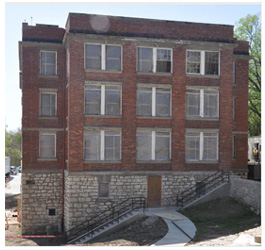 Satterfield & Pontikes Construction is currently renovating the historic Building 427 at Fort Leavenworth, Kansas with a new method of strengthening the load-bearing brick walls without changing the appearance of the building which is listed on the National Register of Historic Places. Built in the 1920s to house military families, the building will now provide office space for the Army post.
Satterfield & Pontikes Construction is currently renovating the historic Building 427 at Fort Leavenworth, Kansas with a new method of strengthening the load-bearing brick walls without changing the appearance of the building which is listed on the National Register of Historic Places. Built in the 1920s to house military families, the building will now provide office space for the Army post.
According to the San Antonio Business Journal, the contractor is adding stainless steel post-tensioning rods inside the brick walls to meet the Department of Defense requirements for progressive collapse protection from blasts. While improving the building to meet a Leadership in Energy and Environmental Design (LEED) certification, they are making the renovations in keeping with historic preservation guidelines. A press release from Satterfield & Pontikes states:
“Project work includes preserving many of the building’s historic architectural features, including original wood trim and hardwood floors, original terrazzo flooring, and exterior window assemblies. Along with extensive renovations and upgrades to meet current building codes, work will also include demolition, abatement, paving, site work, new fire sprinkler systems, and ground-source heat pump mechanical system.”
In another press release, the new method used to reinforce the walls is explained:
“[Some of the] unique aspects of the process include the use of stainless steel post-tensioning rods inserted in 4-inch-diameter cores of approximately 40 feet in depth all the way from the roof parapet to the basement. Standard dry coring methods allow for only 2½-inch cores to a depth of approximately 20 feet. In order to provide a 4-inch diameter core at 40 feet, S&P developed a process of adding weeps and negative pressure to draw the injected water of the wet coring method to the outside of the building, protecting the historic interior finishes. All 28 cores were drilled perfectly plumb with no damage to the interior or exterior surfaces of the historic structure. This innovative method expands the parameters of traditional coring and reinforcement methods in both size and depth and sets a new standard for construction methods.”
The project is expected to be completed this summer.
Historic Army Building Receives Upgrade with Care
by Elizabeth McPherson | April 24, 2012



Add new comment